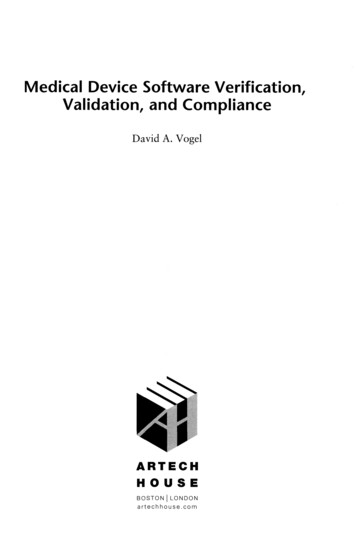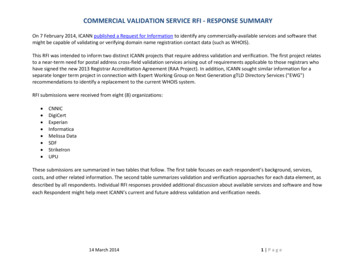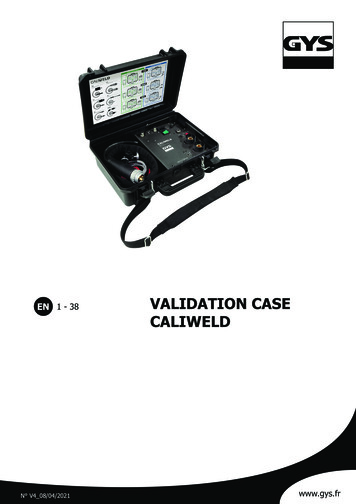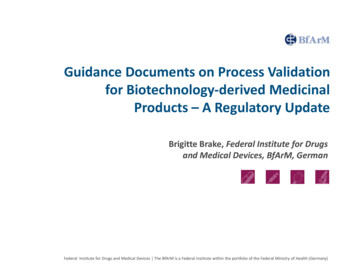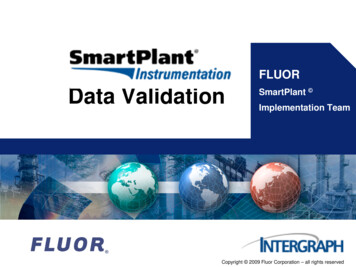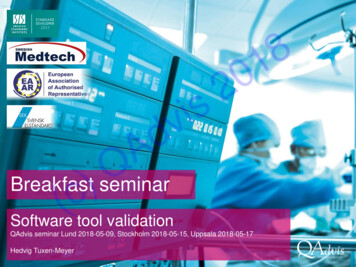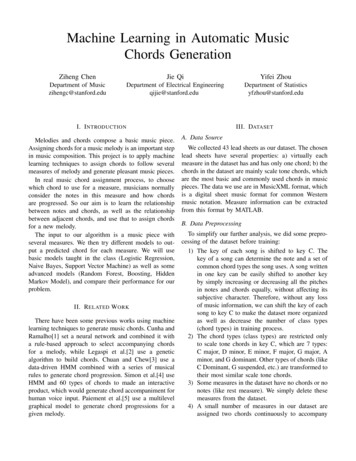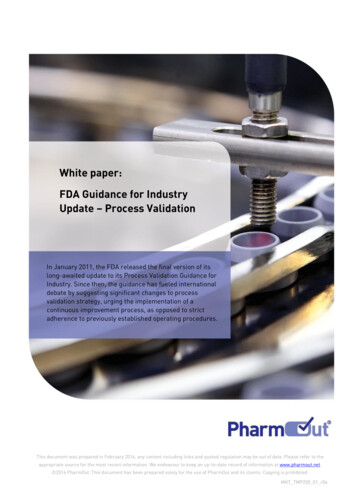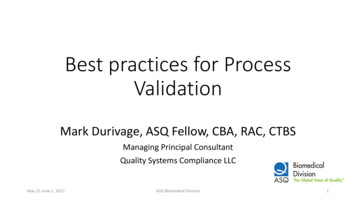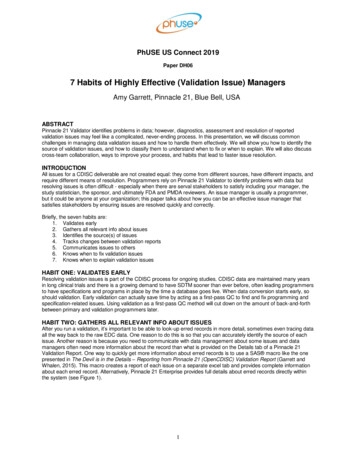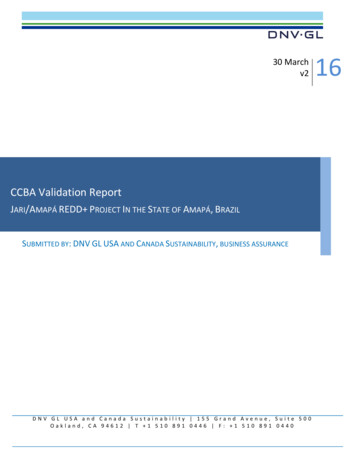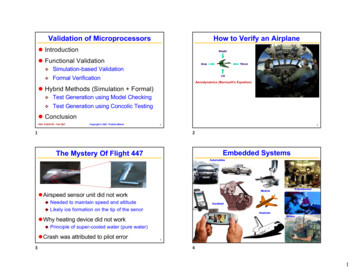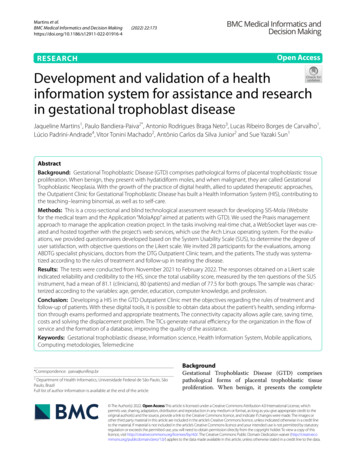
Transcription
Martins et al.BMC Medical Informatics and Decision 022) 22:173Open AccessRESEARCHDevelopment and validation of a healthinformation system for assistance and researchin gestational trophoblast diseaseJaqueline Martins1, Paulo Bandiera‑Paiva2*, Antonio Rodrigues Braga Neto3, Lucas Ribeiro Borges de Carvalho1,Lúcio Padrini‑Andrade4, Vitor Tonini Machado2, Antônio Carlos da Silva Junior2 and Sue Yazaki Sun1AbstractBackground: Gestational Trophoblastic Disease (GTD) comprises pathological forms of placental trophoblastic tissueproliferation. When benign, they present with hydatidiform moles, and when malignant, they are called GestationalTrophoblastic Neoplasia. With the growth of the practice of digital health, allied to updated therapeutic approaches,the Outpatient Clinic for Gestational Trophoblastic Disease has built a Health Information System (HIS), contributing tothe teaching–learning binomial, as well as to self-care.Methods: This is a cross-sectional and blind technological assessment research for developing SIS-Mola (Websitefor the medical team and the Application “MolaApp” aimed at patients with GTD). We used the Praxis managementapproach to manage the application creation project. In the tasks involving real-time chat, a WebSocket layer was cre‑ated and hosted together with the project’s web services, which use the Arch Linux operating system. For the evalu‑ations, we provided questionnaires developed based on the System Usability Scale (SUS), to determine the degree ofuser satisfaction, with objective questions on the Likert scale. We invited 28 participants for the evaluations, amongABDTG specialist physicians, doctors from the DTG Outpatient Clinic team, and the patients. The study was systema‑tized according to the rules of treatment and follow-up in treating the disease.Results: The tests were conducted from November 2021 to February 2022. The responses obtained on a Likert scaleindicated reliability and credibility to the HIS, since the total usability score, measured by the ten questions of the SUSinstrument, had a mean of 81.1 (clinicians), 80 (patients) and median of 77.5 for both groups. The sample was charac‑terized according to the variables: age, gender, education, computer knowledge, and profession.Conclusion: Developing a HIS in the GTD Outpatient Clinic met the objectives regarding the rules of treatment andfollow-up of patients. With these digital tools, it is possible to obtain data about the patient’s health, sending informa‑tion through exams performed and appropriate treatments. The connectivity capacity allows agile care, saving time,costs and solving the displacement problem. The TICs generate natural efficiency for the organization in the flow ofservice and the formation of a database, improving the quality of the assistance.Keywords: Gestational trophoblastic disease, Information science, Health Information System, Mobile applications,Computing metodologies, Telemedicine*Correspondence: paiva@unifesp.br2Department of Health Informatics, Universidade Federal de São Paulo, SãoPaulo, BrazilFull list of author information is available at the end of the articleBackgroundGestational Trophoblastic Disease (GTD) comprisespathological forms of placental trophoblastic tissueproliferation. When benign, it presents the complete The Author(s) 2022. Open Access This article is licensed under a Creative Commons Attribution 4.0 International License, whichpermits use, sharing, adaptation, distribution and reproduction in any medium or format, as long as you give appropriate credit to theoriginal author(s) and the source, provide a link to the Creative Commons licence, and indicate if changes were made. The images orother third party material in this article are included in the article’s Creative Commons licence, unless indicated otherwise in a credit lineto the material. If material is not included in the article’s Creative Commons licence and your intended use is not permitted by statutoryregulation or exceeds the permitted use, you will need to obtain permission directly from the copyright holder. To view a copy of thislicence, visit http:// creat iveco mmons. org/ licen ses/ by/4. 0/. The Creative Commons Public Domain Dedication waiver (http:// creat iveco mmons. org/ publi cdoma in/ zero/1. 0/) applies to the data made available in this article, unless otherwise stated in a credit line to the data.
Martins et al. BMC Medical Informatics and Decision Making(2022) 22:173hydatidiform mole (CHM) and partial hydatidiform mole(PMH). When malignant, it shows the invasive mole, thechoriocarcinoma, a trophoblastic tumor of the placentalsite, and the epithelioid trophoblastic tumor, Gestationaltrophoblastic neoplasia (GTN) [1, 2]. According to theInternational Federation of Gynecology and Obstetrics(FIGO) [3], it is recommended that specialists follow thepatient during the initial diagnosis and the post-molarfollow-up to monitor the dosage of the regression curveof the Human chorionic gonadotropin (hCG) hormone,her hormonal biomarker. It is necessary to diagnose earlyprogression to GTN, with the initiation of chemotherapyperformed by chemotherapy in most cases. Thus, withadequate treatment, there is a chance of a high cure rateand the possibility of a healthy pregnancy [4]. From thisperspective, through correct decisions, diagnostic andtherapeutic actions for disease prevention and recoveryare based on research, exchange of information, and scientific evidence.In this sense, with the growth of the practice for digitalhealth and the need for clinical follow-up combined withupdated therapeutic approaches, the Gestational Trophoblastic Disease Outpatient Clinic, one of the ReferenceCenters in Brazil, by the University Hospital/Hospital SãoPaulo, Escola Paulista de Medicina, from the Federal University of São Paulo (HU/HSP/EPM-Unifesp), specialized in the treatment, care, and research, undertook theconstruction of a Health Information System (HIS), composed of two simultaneous interfaces: a Website (responsive site) for the medical team, which, associated with anApplication (MolaApp) aimed at patients, contribute tothe teaching–learning binomial, as well as to self-care [5].With regard to inserting Information and Communication Technologies (ICTs) in the provision of health services, it impacts changes in the professionals’ learningprocess by establishing a new “doctor-internet-patient”relationship, considering quality, safety, security, and efficiency in the assistance provided [6].From this real-time or remote computing, these toolscan help treatments in different geographic regions,reduce time and cost and improve communication quality, promoting specialized coverage of health care thatcan be disseminated to other GTD Reference Centers inBrazil.Another essential factor for the educational assistanceof these patients undergoing GTD treatment, their families, and other interested people is the use of social mediaand digital platforms that enable pedagogical and innovative initiatives for health education. Diniz et al. [7] reportthe experience of online interaction, through a Facebookpage, between the directors of the Brazilian Association of Gestational Trophoblastic Disease (ABDTG) andpatients with hydatidiform mole, whose study showedPage 2 of 12positive results in terms of satisfaction, security andunderstanding of the information and guidance provided,even remotely.In a recent study, results obtained in a data surveyregarding self-care and benefits promoted to the psychological, social, and financial aspects of the patientsemphasize the importance of telemedicine for post-molarcare and follow-up in the comparison between being aface-to-face care or through a mobile devices, via WhatsApp [8]. This study was carried out in the same Reference Center in GTD of our research.In addition, in similar scenarios, Paulista Associtationof Medicine (APM) surveyed 1,614 professionals to mapthe use of digital solutions in routine care in the state ofSão Paulo (Brazil), where 82.65% of physicians use thetechnology in their day-to-day, to observe patients or tooptimize appointments. The objective of this study wasto map the use of technological resources in Medicineand Health, and 67.66% of respondents agreed with thephrase “Technology will not replace the doctor, but it canreplace the doctor who does not use technology”. And,in fact, among the interviewees, 93.68% understand thatsharing information benefits everyone involved [9].Other literary studies have analyzed the use of telemedicine to facilitate the provision of services associated withhealth care, including cases in which distance is a critical factor. They showed that research related to the useof digital tools attested to a good gain for the relationshipbetween health professionals and their patients, with theinsertion of the “Meu Pré-Natal” Application (womenduring pregnancy, childbirth, and the puerperium) [10].In the same way, the results obtained in the “Evaluationof Mobile Applications for Health Promotion of PregnantWomen with Pre-Eclampsia” proved the possibility ofverifying the reliability of the tools, as well as the information being consistent with promoting health and thequality of life of these pregnant women [11].The motivation for the HIS construction was due tothe lack of published works that portray the interactionbetween two technological devices developed, with asimultaneous application, as tools to help in the processof treatment of GTD, and by the diffusion of frequentaccess to computers, tablets, and smartphones, as a facilitator in communication.For improved care and distance services to representa significant opportunity in needy and remote regions,where specialized face-to-face care is not available, theapplication of low-cost technologies is necessary. Itshould be encouraged the implementation of integratedcollaborative networks for remote assistance [12].In this sense, with the advancement of ICTs, mobileapplications aimed at the health area act as tools for selfmanagement in diseases aiming at the process of mutual
Martins et al. BMC Medical Informatics and Decision Making(2022) 22:173responsibility, which facilitates the achievement of clinical results in the conduct of treatments and a promisingproposal for the self-care at home [12].Nowadays, cell phones are no longer used only forphone calls or receiving and sending messages. They areincreasingly developed with advanced technologies anddata storage capacity for the benefit of users [13].When it comes to ethical and legal aspects, it can behighlighted that technological advances are impacting allhealth network processes, from communication to information collection. Its merger affects all dealings relatedto new medical procedures and other health procedures.In Brazil, norms and regulations defined therapeuticguidelines that subsidized the insertion of ICTs, due tothe changes that occurred during the Covid-19 pandemic[14–16].Given these considerations, the question that guidedthe development of this research was: “What are theadvantages and benefits of developing a system capableof promoting adequate post-molar follow-up and earlydiagnosis of its malignancy called Gestational Trophoblastic Neoplasia through ICTs?”.MethodologyThis is a transversal and blind technological evaluationresearch for the development of a Health InformationSystem (HIS), composed of two interfaces: The website(responsive site) for the activities of the medical teamand the Application (MolaApp) for the patients. Theproject phases were defined by techniques used by software engineering, which included requirements analysis,programming, and development of digital tools, as wellas application of tests and evaluation questionnaires.The study was developed according to the rules of carePage 3 of 12and follow-up at the GTD Outpatient Clinic—HU/HSP/EPM/UNIFESP.For this undertaking, a team was formed with a projectmanager, a requirements analyst, two programmers, andfour systems analysts. The requirements analyst belongsto the Discipline of Neonatology, and the others belongto the Project Office of the Department of Health Informatics at Unifesp. In addition, we had the assistance andsupervision of the advisor and coordinator of the GTDAmbulatory, as well as the Technical Assistance in HealthInformatics’s co-orientation of this work.Bibliographic surveys and literature review were performed in databases indexed in PubMed, Scielo, Lilacs,and Web of Science.This research was submitted andapproved by the Research Ethics Committee of the Federal University of São Paulo, on March 27, 2020.Project management method for the developmentof the Health Information SystemFor the project management of creating the application, website, and mobile application, we used the Praxis[17] project management approach. This approach wasselected because it is free to use, flexible to our needs,and comprehensive. It offers a body of knowledge, methodology, competency framework, maturity model, andterminology in a single integrated structure.The approach involves the components presented(Fig. 1) and described below: Patronage process: According to the Praxis Framework, it is the process that “a patron must undertaketo exercise overall control and make key decisionsduring the life cycle”. This process was assisted by theproject manager and conducted by the coordinator ofFig. 1 Praxis Framework project and program process [17]. Source: https:// www. praxi sfram ework. org/ en/ method/ proje ct- and- progr amme- proce sses
Martins et al. BMC Medical Informatics and Decision Making (2022) 22:173the GTD Ambulatory and supervisor of this research,ensuring the medical team’s perspective and requirements. It was part of these steps: meetings at the endof each downstream process and during the handover process for scope adjustment and follow/no follow decision making.Participating team: Specialist GTD coordinator andproject manager.Identification process: The initial stage—During thisprocess, a project summary was developed, the effortnecessary to define it in-depth, and submitted to theauthorization of the project sponsor.Participating team: Specialist GTD coordinator, oneproject manager, one requirements analyst, two programmers, one system analyst.Definition process: In this step, the project plan isfully developed. A task list with reliable estimates,an arrow diagram that later became a gantt chart, anentity-relationship graph, and a description of theproject’s governance guidelines were created.Participating team: Specialist GTD coordinator, oneproject manager, one requirements analyst, two programmers, and one system analyst.Delivery Process: This is the process in which theWebsite and MolaApp application were developed.It has been divided into development cycles withgo/no-follow decision-making boundaries. It allowsscope changes and accommodates dependencies andrisks encountered during the delivery process thatwere not anticipated in previous methods.Participating team: 1 project manager, one requirements analyst, two programmers, and one systemanalyst.Page 4 of 12 Closing Process: Tasks performed are compiled,reviewed, and accepted by the project sponsor. Products (MolaApp website and app) are delivered, andlessons learned during all processes are reviewed anddiscussed. Participating team: Specialist GTD coordinator, oneproject manager, one requirements analyst, two programmers, and one system analyst. Benefits realization process: Developing products does not automatically bring benefits. In thisresearch, this process comprised the Validation andevaluation of this Health Information System. Participating team includes nine doctors from theGTD outpatient clinic—HU-HSP/EPM/UNIFESP,five from the ABDTG, and 14 patients with GTD.Consequently, in the delivery process, the development tasks were performed using a services-orientedarchitecture [18] comprising two interfaces (medical staffand patients) and intermediated by a services layer thatcommunicates between the interfaces and the data bank.For tasks involving real-time chat, a WebSocket layer wascreated, and hosted with the project’s web services. Thisproject was hosted on two servers and used an application interface made for patients, as shown in Fig. 2.The servers use the Arch Linux [19] operating systemand are divided as follows:1. A database server using the MariaDB [20] databasemanagement system to store application data andmaintain consistency between parts of the system.2. A server with web services made with nodeJS [21]that maintains the services used by the website andFig. 2 Application services architecture covering server 1, containing web services, websockets, single page application (SPA) site, which is themedical team’s interface; server 2 with a MariaDB database; and the android application, which is the patient interface [19]
Martins et al. BMC Medical Informatics and Decision Making(2022) 22:173Page 5 of 12Fig. 3 Submission of exams: X-ray screenthe mobile application and communicates with thedatabase. The SPA site is also hosted on this sameserver, using the Quasar Framework [22]. A WebSocket was also hosted on this server using socket.io [23] to mediate real-time chat communicationbetween the physicians’ and patients’ interface usingthe vue-socket [24] library.3. An application with patient interfaces developedusing the Quasar framework [22] and exported usingthe integrated cordova library.HIS: web interface and MolaApp applicationThe Health Information System about GestationalTrophoblastic Disease (GTD) and related Neoplasms wasintended to provide patients and their families with agility in sending the results of collected exams, obtaininginformation, and providing clarifications in case of needvia the internet. line. Providing the medical team with theopportunity to record longitudinal clinical data from thetreatment.System scope and users Web Interface: The Website contains all resources forregistering patients with their personal, clinical, anddemographic data, encompassing all activities relevant to the GTD Ambulatory. For example, belowwe have the screen for organizing the x-rays sent bypatients (Fig. 3)The coordinator has the attributes of all registeredprofiles of the medical team (professor, preceptor, residents, and interns), in addition to managing all HISfunctionalities, via the Website or Application. You willbe able to issue individual reports of patients or a groupof patients, either longitudinally, to view the treatment,or transversal, to observe only one event, via the Webplatform.The doctor performs the consultations and willinclude the clinical data and updates of the registrationdata through the Web environment and will be able toview the report of these and send messages and guidelines via chat. MolaApp Application: It will be used exclusively bythe patients in attendance to assist in the generalcommunication, interaction, and follow-up of thetreatment (Fig. 4).When performing tests in other laboratories, patientsmay include clinical data, accompanied by reports orphotographs, via the MolaApp Application. They willhave a longitudinal follow-up of the results obtained bythe doctor who performed the care. In addition, theywill receive alert messages regarding the frequency ofexams or when there is a variation from one exam toanother so that they can contact the Reference Center.Both the Website and the MolaApp Application developed were composed of concepts, risk factors, signs,symptoms, treatments, importance of medication and
Martins et al. BMC Medical Informatics and Decision Making(2022) 22:173Page 6 of 12Evaluation of quality of use and functionalityFive specialists in GTD, who are members of the ABDTGstudy group, were invited to coordinate the care provided in Brazil [25], as well as nine doctors from theGTD Ambulatory team (HUHSP/EPM/UNIFESP) and14 patients with the diagnosis. After accepting the Termsof Free and Informed Consent, a brief personal trainingtook place to clarify the actions to be carried out with thedevices.Regarding the evaluations, we provide questionnairesdeveloped in a REDCap environment, followed by anInstruction Manual for the use of the Mola System,containing illustrative images that help understand thestep-by-step process for carrying out practical activities(complementary material).The Questionnaire of Patients with Gestational Trophoblastic Disease (https:// redcap. epm. br/ surve ys/?s RTCKC LRKP4 MLXETF) is composed of two parts. Thefirst was for demographic questions of the participants,and the second with ten questions from the System Usability Scale and an optional essay question [26].The Occurrence Questionnaire (https:// redcap. epm. br/ surve ys/?s RLKMX P8ANE KEPDEE) identified the user,doctors, or patients and recording problems in the use ofthe website or the MolaApp application (Fig. 5).Fig. 4 Chat’s screen between physician and patient (MolaApp)side effects, frequent questions, necessary health careand patient follow-up through monitoring, with the purpose of provide clarification, encourage therapeutic careand the importance of continuity in treatment. The User’sManual (in Portuguese) is provided as Additional file 1.Fig. 5 Occurrence questionnaireResultsThe tests were carried out from November 2021 to February 2022, and 28 eligible participants (14 in bothgroups) were invited to carry out the usability and functionality assessments for the study, distributed amongphysicians from ABDTG, physicians from the DTG outpatient clinic, and patients undergoing treatment. Fourteen responses were obtained, 9 clinicians and 5 patients,which represents a 50% return rate.Sample characteristicsThe clinicians and patients’ sample was characterizedin relation to the variables: age, sex, education, computer knowledge and profession (Tables 1, 2).
Martins et al. BMC Medical Informatics and Decision Making(2022) 22:173Table 1 Clinicians’ sample characteristics (n 9)CharacteristicsSexFemale5 (55.6)AgeMean (standard deviation)45 ation1 (11.1)Specialization4 (44.4)Master degree0Doctorate degree4 (44.4)Computer knowledgeBasic3 (33.3)Intermediary5 (55.6)Advanced1 (11.1)Table 2 Patients’ sample characteristics (n 5)CharacteristicsSexFemale5 (100)AgeMean (standard deviation)34 tion3 (60)Specialization2 (40)Computer knowledgeBasic2 (40)Intermediary3 (60)User’s satisfaction evaluationAfter the evaluation phases, using the System Usability Scale—SUS, to determine the degree of user satisfaction with the final product, website by clinicians,and app by patients, the questionnaire contained tenobjective questions graded on a Likert scale, with values from one to five, classified respectively such as:“strongly disagree”, “disagree”, “do not agree nor disagree”, “agree” and “strongly agree” (Figs. 6, 7), and anoptional essay question. Data were collected in a formdeveloped in REDCap and analyzed in Microsoft Excel2010 for Windows and R software, version 4.1.2. [26].The total usability score measured by the ten questions of the SUS instrument presented a mean of 81.1for the clinicians’ group and 80 for the patients’ group.Page 7 of 12The median was 77.5 points for both groups. All resultswere classified by excellent (72.5–85), considering adjective scale and acceptability ranges ( 68), showed in Fig. 8[27].Accurate quality of use is related to the ability andease of users to achieve their goals with efficiency andsatisfaction, communicability (quality of doctor-patientcommunication through the interface), and applicability(usefulness in different situations) [28].About the questionnaire of occurrences during the useof the system, 13 responses were obtained, where 11 indicated the absence of problems, and two doctors from theHU-HSP reported having difficulty accessing the system.Association analysisThe association between age and SUS Score was studied using Pearson’s correlation coefficient since the SUSScore variable showed adherence to the normal distribution by the Shapiro–Wilks test (p 0.05). The Pearsoncorrelation result for clinician’s group was 0.541, whichmeans a low correlation, and 0.110 for the patients’group. In this group, the correlations were significantlyand inversely proportional; the younger the age, thehigher the SUS score.DiscussionEven though only 50% of the total number of invited participants, the amount was enough for the users to validate the system.According to studies already carried out to measurethe minimum number of participants in evaluations, fiveusers are needed among the categories per performance.In the case of different groups, such as the developed HIS(doctors and patients), five users are also recommended.Therefore, with this selected group, it was possible tocover up to 80% of usability problems that could havebeen found [29].On the other hand, too, research suggests that there isno consensus on the ideal size. However, five users mayunderestimate the number of errors, concluding thatthey should use eight to nine users to eliminate problemswith a small sample size [30].The present study had 14 users, representing a sampleabove the minimum numbers indicated for usability testsand their validation.All participants assessed usability through a questionnaire based on the System Usability Scale (SUS) during the tests. The answers to the questionnaire showedgood reliability and credibility to the developed system.The SUS score for physicians and patients was 81.1 and80, respectively, is classified as excellent and acceptableaccording to the SUS Adjective Rating Scale [27].
Martins et al. BMC Medical Informatics and Decision MakingStrongly disagreeDisagree(2022) 22:173Page 8 of 12Do not agree nor disagreeAgreeStrongly agreeI think that would like so use this product frequentlyI found the product unnecessarily complexI thought the product was easy to useI think that I would need the support of a technical person tobe able to use this productI found the various functions in this system were wellintegratedI thought there was tto much inconsistency in this systemI would imagine that most people would learn to use thissystem very quicklyI found the system very cumbersome to useI felt very confident using the productI needed to learn a lot of things before I could get going withthis product0102030405060708090100Fig. 6 System usability scale: clinicians’ evaluation (%)Strongly disagreeDisagreeDo not agree nor disagreeAgreeStrongly agreeI think that would like so use this product frequentlyI found the product unnecessarily complexI thought the product was easy to useI think that I would need the support of a technical person tobe able to use this productI found the various functions in this system were wellintegratedI thought there was tto much inconsistency in this systemI would imagine that most people would learn to use thissystem very quicklyI found the system very cumbersome to useI felt very confident using the productI needed to learn a lot of things before I could get going withthis product0Fig. 7 System usability scale: patients’ evaluation (%)102030405060708090100
Martins et al. BMC Medical Informatics and Decision Making(2022) 22:173Page 9 of 12Fig. 8 SUS classified scaleThe association of age with the SUS score by Pearson’s correlation was 0.541 (physicians) and 0.110(patients). The negative number represents an inverselyproportional relationship between the two variables, andits correlation varies between 1 and 1; that is, thevalue should be close to the extremities, which occurredwith the patient group. The group of participants regarding academic training presented similar results.Regarding usability, being the individual’s ability tounderstand and operate a software used for specific purposes [31], in the feedback from the evaluations, this stepwas confirmed by the participants.According to the literature, a SUS score above 68 indicates an acceptable degree of usability [32]. An extensiveanalysis of the SUS questionnaire’s application identified that a score of 85 would be associated with excellentacceptance of a software or an application [27]. In thissense, the average SUS score for evaluating the system’susability reached the parameters described in the literature [27].The choice of SUS for application in health was basedon the number of questions, reliability, interpretationof the score, ease of deployment and online distribution, and previous studies carried out in the health area[33–37].The System Usability Scale (SUS) is a research instrument, developed by Brooke in 1986, which contains tenquestions that aim to measure the usability of variousproducts and services. In relation to other existing assessment instruments (ASQ, CSUQ, PSSUQ, USE, SUMI,WAMMI), it has many advantages. First, the instrumentis technologically agnostic, so it can be used to evaluatevarious products and services, including websites, hardware, multimodal systems, voice command systems,mobile applications, and clinical systems [33, 36].This instrument is highly robust and versatile for usability professionals. In addition to the features mentionedabove, the survey becomes relatively quick and easy tobe used by both participants and administrators. Finally,the instrument generates a single score on a scale that iseasily understood by most of those involved in the project, from project managers to programmers. This pointis important, as the actors involved may have little or noexperience in human factors and usability. One of thebiggest advantages of the System Usability Scale is thatthere is no copyright, making the cost recommendable[34].It is also easy to administer, has good reliability and references that help in the interpretation of its score [36].The present study is a pioneer in this path for the benefit of p
care and follow-up in the comparison between being a face-to-face care or through a mobile devices, via What-sApp [8]. is study was carried out in the same Refer-ence Center in GTD of our research. In addition, in similar scenarios, Paulista Associtation of Medicine (APM) surveyed 1,614 professionals to map
